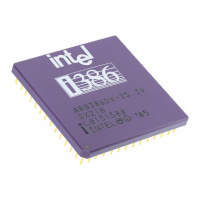INTERRUPTS
AND
EXCEPTIONS
Table 9-1, Trap and
Interrupt
Gate Checks
Check
Interrupt vector
is
in
lOT
limit
Trap, Interrupt, or Task Gate
in
lOT
Entry
If
INT
instruction, gate
OPL
CPL
P bit of gate is
set
Code segment selector
is
in
descriptor table
limit
CS selector refers to a code segment
If
code segment
is
non-conforming, Code Segment
OPL
=:;
CPL
If
code segment
is
non-conforming, and
OPL
<
CPL
and
if
SS
selector
in
TSS
is
in
descriptor table
limit
If
code segment is non-conforming, and
OPL
< CPL and
if
SS
is
a writable data segment
If
code segment
is
non-conforming, and
OPL
< CPL and
code segment
OPL
= stack segment
OPL
If
code segment is non-conforming, and
OPL
<CPL
and
if
SS
is
present
If
code segment is non-conforming, and
OPL
<
CPL
and
if
there
is
enough space for 5 words on the stack (or 6
if
error
code is required)
If
code segment
is
conforming, then
OPL
=:;CPL
If
code segment
is
not present
If
IP
is not
within
the
limit
of code segment
•
GP
= General Protection Exception
NP
=
Not
Present Exception
SF
= Stack Fault
, '
','.
Exception'
Error Code
GP
lOT
entry X 8 + 2 +
EXT
GP
IDTentry X 8 + 2 +
EXT
GP
lOT
entry X 8 + 2 +
EXT
NP
lOT
entry X 8 + 2 +
EXT
GP
CS selector X 8 +
EXT
GP
CS selector X 8 +
EXT
GP
CS selector X 8 +
EXT
T8
88
selector X 8 +
EXT
TS
SS selector X 8 +
EXT
TS Stack segment selector +
EXT
SF Stack segment selector +
EXT
SF SS selector +
EXT
GP
Code segment selector +
EXT
NP
Code segment selector +
EXT
GP
0+
EXT
Like the
RET
instruction,
ntET
is
restricted
to
return to a level
of
equal or lesscr privilege unless a
task switch occurs. The
IRET
instruction works like the inter-segment
RET
instruction except
that
the
flag
word
is popped and
no
stack pointer update for parameters
is
performed since
no
parameters are
on the stack. See section 7:5.2 for information on inter-level returns. '
To distinguish an inter-ievel
IRET,
the
new
CPL
(which is the
RPL
of the return
CS
selector)
is compared with the current CPL.
If
they are the same, the
IP
and flags are popped and execution
continues. '
An
inter-level return via
IRET
has all the same checks as shown in table
7-4.
The only difference
is
the
extra
word
on
the stack for the old flag word.
Interrupt gates are typically associated with high-priority hardware interrupts for automatically disabling
interrupts upon their invocation. Trap gates are typically software-invoked since they do not disable
,the
maskable hardware interrupts. However, low-priority interrupts
{e.g.;a
timer) are often invoked
via a
trap
gate to allow other devices
of
higher priority to 'interrupt
the
handler of
that
lower priority
interrupt.
9-6
